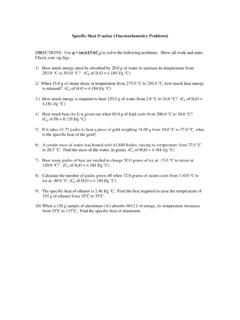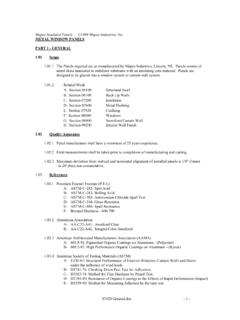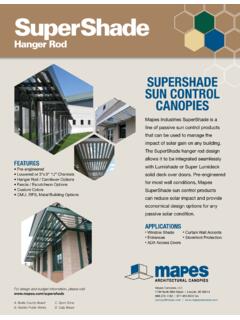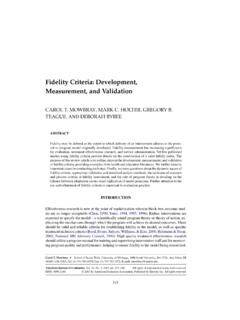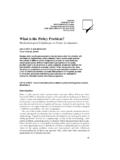Transcription of APES ACID RAIN SEED LAB - Kwanga.net
1 1 APES acid rain seed LAB OBJECTIVES To review prior knowledge of acid rain . To study current EPA acid rain information and research. To see the effects of acid rain in a laboratory setting. To observe how acidic water affects the germination of seeds. MATERIALS (per group) 2 clear plastic cups 10 pre-soaked lima beans masking tape cotton balls permanent markers beaker or cup of tap water beaker or cup of white vinegar droppers acid rain info. from potting soil PROCEDURE Day 1 1) Write a hypothesis: How will the growth of the beans in the acid rain cup be affected? To what degree will the growth be affected? 2) Place a strip of masking tape on each cup.
2 Label one cup acid rain and the other cup rain . Also, label each cup with your station and class period numbers. 3) Insert the cotton around the inside of each cup. 4) For each cup, place five beans between the cotton and the side of the cup. You should be able to see the beans against the side of the cup. 5) With tape labels or a marker, label below each bean on the outside of each cup, with a number 1-5. 6) Use the dropper to add vinegar to the acid rain cup until all the cotton is damp. 7) Use the dropper to add water to the rain cup until all the cotton is damp. 8) Put both cups in the designated place. 9) Construct a data table and record your observations.
3 Day 2-4 1) Observe the seeds. Record your observations. 2) Make a sketch of each bean on plain white paper using accurate colors. Label clearly. 3) Check the cups for dryness and remoisten when needed: water the acid rain cup with vinegar, and water the rain cup with tap water. Day 5 1) Carefully remove the beans from the cups. Lay them out on paper towels. Make a sketch of each bean on plain white paper using accurate colors. Label clearly. 2) Take three beans from each cup and plant them in potting soil, using the original cups. Discard extra beans and cotton. 3) Water the acid rain cup with vinegar, and water the rain cup with water. 4) You will be checking the growth of your bean plants periodically.
4 Check them daily for dryness. WHAT TO HAND IN: Hypothesis Lab Questions # 1-6 Data I: Qualitative Anecdotal Log acid rain EPA info. questions # 7-25 Data II: Sketches (day 2-5) 2 DATA I: QUALITATIVE ANECDOTAL LOG Day 1 (date?) : Observations of beans in acid rain cup and rain cup Day 2 (date?) : Observations of beans in acid rain cup and rain cup Day 3 (date?) : Observations of beans in acid rain cup and rain cup Day 4 (date?) : Observations of beans in acid rain cup and rain cup Day 5 (date?) : Observations of beans in acid rain cup and rain cup DATD II: SKETCHES day 2-5 (in color, on plain white paper) acid rain cup, bean 1 acid rain cup, bean 2 acid rain cup, bean 3 acid rain cup, bean 4 acid rain cup, bean 5 rain cup, bean 1 rain cup, bean 2 rain cup, bean 3 rain cup, bean 4 rain cup, bean 5 LAB QUESTIONS 1) Write a group KWL (what do you Know what do you Want to know what did you Learn) about acid rain .
5 Fill in the L portion after the lab is completed. 2) How many beans germinated in the rain cup? What percentage of germination was observed? 3) Is the result from question 2 what you expected? Explain. 4) How many beans germinated in the acid rain cup? What percentage of germination was observed? 5) Is the result from question 4 what you expected? Explain. 6) Why is acid rain considered to be an international problem rather than a local problem? When finished reading the acid rain information from the EPA, answer these questions: 7) What are the two parts to acid deposition? Give an example of each. 8) What is buffering capacity? 9) Construct a two-circle Venn diagram about wet and dry deposition.
6 10) What is the role of prevailing winds? 11) What two substances are the primary causes of acid rain ? 12) In the , what is listed as the main source of these chemicals? 13) How is acid rain made? 14) What are the names and chemical formulas of the two acids in acid rain ? 15) What is pH? 16) What is the numerical range for pH? 17) Which pH number is neutral? 18) Construct a two-circle Venn diagram about acids and bases. 19) Why is normal rainfall slightly acidic? 20) What is the national Atmospheric Deposition Program? 21) What is CASTNET? 22) What is visibility reduction? 23) What is acidification? 24) What can acid rain do to buildings and statues?
7 25) What is particulate matter? 3 acid rain information from What is acid rain and What Causes It? acid rain is a broad term used to describe several ways that acids fall out of the atmosphere. A more precise term is acid deposition, which has two parts: wet and dry. Wet deposition refers to acidic rain , fog, and snow. As this acidic water flows over and through the ground, it affects a variety of plants and animals. The strength of the effects depend on many factors, including how acidic the water is, the chemistry and buffering capacity (the ability to neutralize acidic compounds) of the soils involved, and the types of fish, trees, and other living things that rely on the water.
8 Dry deposition refers to acidic gases and particles. About half of the acidity in the atmosphere falls back to earth through dry deposition. The wind blows these acidic particles and gases onto buildings, cars, homes, and trees. Dry deposited gases and particles can also be washed from trees and other surfaces by rainstorms. When that happens, the runoff water adds those acids to the acid rain , making the combination more acidic than the falling rain alone. Prevailing winds blow the compounds that cause both wet and dry acid deposition across state and national borders, and sometimes over hundreds of miles. Scientists discovered, and have confirmed, that sulfur dioxide (SO2) and nitrogen oxides (NOx) are the primary causes of acid rain .
9 In the , about 2/3 of all SO2 and 1/4 of all NOx comes from electric power generation that relies on burning fossil fuels like coal. acid rain occurs when these gases react in the atmosphere with water, oxygen, and other chemicals to form various acidic compounds. Sunlight increases the rate of most of these reactions. The result is a mild solution of sulfuric acid (H2SO4) and nitric acid (HNO3). How Do We Measure acid rain ? acid rain is measured using a scale called pH. The pH scale measures how acidic or basic a substance is. It ranges from 0 to 14. A pH of 7 is neutral. A pH less than 7 is acidic, and a pH greater than 7 is basic. Mixing acids and bases can cancel out their extreme effects, much like mixing hot and cold water can even out the water temperature.
10 Normal rain is slightly acidic because carbon dioxide (CO2) dissolves in it, so it has a pH of about In recent years, the most acidic rain falling in the US has a pH of about acid rain 's pH, and the chemicals that cause it, are monitored by two networks supported by EPA. The National Atmospheric Deposition Program measures wet deposition. The Clean Air Status and Trends Network (CASTNET) measures dry deposition. What Are acid rain 's Effects? acid deposition has a variety of effects, including damage to forests and soils, fish and other living things, materials, and human health. acid rain also reduces how far and how clearly we can see through the air, an effect called visibility reduction.








